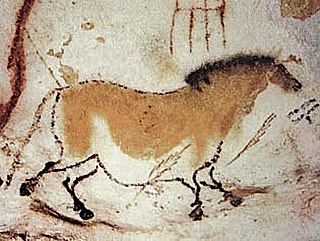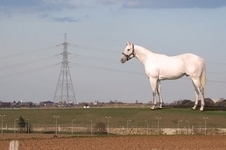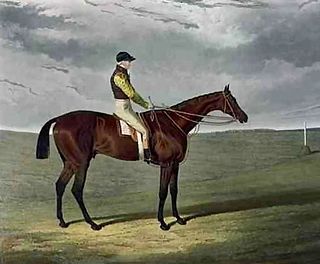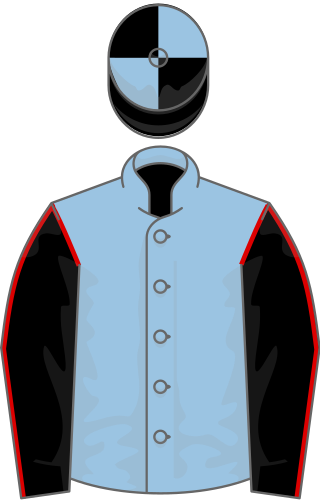Related Research Articles

Mark Wallinger is an English artist. Having previously been nominated for the Turner Prize in 1995, he won in 2007 for his installation State Britain. His work Ecce Homo (1999–2000) was the first piece to occupy the empty fourth plinth in Trafalgar Square. He represented Britain at the Venice Biennale in 2001. Labyrinth (2013), a permanent commission for Art on the Underground, was created to celebrate 150 years of the London Underground. In 2018, the permanent work Writ in Water was realized for the National Trust to celebrate the Magna Carta at Runnymede.

Phar Lap was a champion Australian Thoroughbred racehorse. Achieving incredible success during his distinguished career, his initial underdog status gave people hope during the early years of the Great Depression. He won the Melbourne Cup, two Cox Plates, the Australian Derby, and 19 other weight-for-age races.
Conceptual art, also referred to as conceptualism, is art in which the concept(s) or idea(s) involved in the work are prioritized equally to or more than traditional aesthetic, technical, and material concerns. Some works of conceptual art may be constructed by anyone simply by following a set of written instructions. This method was fundamental to American artist Sol LeWitt's definition of conceptual art, one of the first to appear in print:
In conceptual art the idea or concept is the most important aspect of the work. When an artist uses a conceptual form of art, it means that all of the planning and decisions are made beforehand and the execution is a perfunctory affair. The idea becomes a machine that makes the art.

Seabiscuit was a champion thoroughbred racehorse in the United States who became the top money-winning racehorse up to the 1940s. He beat the 1937 Triple Crown winner, War Admiral, by four lengths in a two-horse special at Pimlico and was voted American Horse of the Year for 1938.

Eclipse was an undefeated 18th-century British Thoroughbred racehorse who won 18 races, including 11 King's Plates. He raced before the introduction of the British Classic Races, at a time when four-mile heat racing was the norm. He was considered the greatest racehorse of his time and the expression, "Eclipse first, the rest nowhere" entered the English vernacular as an expression of dominance.

Fountain is a readymade sculpture by Marcel Duchamp in 1917, consisting of a porcelain urinal signed "R. Mutt". In April 1917, an ordinary piece of plumbing chosen by Duchamp was submitted for an exhibition of the Society of Independent Artists, the inaugural exhibition by the Society to be staged at the Grand Central Palace in New York. When explaining the purpose of his readymade sculpture, Duchamp stated they are "everyday objects raised to the dignity of a work of art by the artist's act of choice." In Duchamp's presentation, the urinal's orientation was altered from its usual positioning. Fountain was not rejected by the committee, since Society rules stated that all works would be accepted from artists who paid the fee, but the work was never placed in the show area. Following that removal, Fountain was photographed at Alfred Stieglitz's studio, and the photo published in the Dada journal The Blind Man. The original has been lost.

The readymades of Marcel Duchamp are ordinary manufactured objects that the artist selected and modified, as an antidote to what he called "retinal art". By simply choosing the object and repositioning or joining, titling and signing it, the found object became art.

Timeform is a sports data and content provider located in Halifax, West Yorkshire, England. Founded in 1948, it provides systematic information on form to punters and others involved in the horse racing industry. The company was purchased by the sports betting exchange Betfair in December 2006. Since 2 February 2016, it has been owned by Flutter Entertainment.
Seb Sanders is a former flat race jockey. Sanders was British Champion Flat Jockey in 2007, a title he shared with Jamie Spencer.

Elitloppet or Solvallas Internationella Elitlopp is an annual, invitational Group One harness event that has taken place at Solvalla Racetrack in Stockholm, Sweden, since 1952. The competition is regarded as one of the most prestigious international events in trotting. The winner is decided through two qualifying rounds and a subsequent final later the same day. Both the eliminations and the final are raced over the mile. The overall purse for the 2022 event was SEK11,350,000, equalling approximately US$1,073,000. In 2002 the Italian champion Varenne,, took it in a world record time of 1:10.4 in the elimination and then bested that mark by winning the final in 1:10.2 – the fastest mile ever trotted around three turns. The fastest winning time in a final is 1:08.9, run by the Swedish Don Fanucci Zet in 2021. Elitloppet was part of the European Grand Circuit and is part of that circuit's successor, the UET Masters Series.
Horse Chestnut was a champion thoroughbred racehorse bred in South Africa by Harry F. Oppenheimer at his Mauritzfontein Stud in Kimberley. His sire Fort Wood was a son of the British champion sire, Sadler's Wells. He was defeated once in his racing career of 10 starts. He was nominated as the first equine inductee into the South African Equine Hall of Fame in 2019 but lost the vote to Sea Cottage.

Horses have appeared in works of art throughout history, frequently as depictions of the horse in battle. The horse appears less frequently in modern art, partly because the horse is no longer significant either as a mode of transportation or as an implement of war. Most modern representations are of famous contemporary horses, artwork associated with horse racing, or artwork associated with the historic cowboy or Native American tradition of the American West. In the United Kingdom, depictions of fox hunting and nostalgic rural scenes involving horses continue to be made.

The White Horse at Ebbsfleet, formerly the Ebbsfleet Landmark, colloquially the Angel of the South, was a planned white horse statue to be built in the Ebbsfleet Valley in Kent, England. Designed by Mark Wallinger to faithfully resemble a thoroughbred horse, but at 33 times life size, the colossal sculpture was to be 50 metres (160 ft) high.

Plenipotentiary (1831–1854) was a British Thoroughbred racehorse and sire. In a career that lasted from April 1834 to April 1835 he ran seven times and won six races. His most important win came in May 1834 when he won The Derby. His only defeat, in the St Leger at Doncaster later that year, was widely believed to be the result of foul play. After three successes as a four-year-old in 1835 he was retired to stud where his record was disappointing. Plenipotentiary was regarded by racing experts as one of the best British racehorses of his era.

Frederick (1826–1837) also known as "Frederic", was a British Thoroughbred racehorse and sire. In a career that lasted from June 1829 to August 1831 he ran five times and won once. His only win came on his racecourse debut, when he recorded an upset victory in the 1829 Derby ridden by his sixty-year-old trainer John Forth. Frederick failed to reproduce his Derby-winning form, finishing no better than third in four subsequent races.
Machiavellian was an American-bred Thoroughbred racehorse and sire. In a racing career which lasted from August 1989 to August 1990 he ran seven times and won four races. He was the leading French two-year-old of 1989 when he was unbeaten in three races including the Group One Prix Morny and Prix de la Salamandre. He later became a highly successful sire of winners.

Mr Mulligan was an Irish-bred, British-trained Thoroughbred racehorse. He was a specialist steeplechaser who ran twelve times and won seven races under National Hunt rules. After mixed success in Point-to-point, Mr Mulligan rose to prominence by winning five successive races of increasing importance in the 1995/1996 National Hunt season. He became known for his front-running style and occasionally erratic jumping. In the following year he appeared to have lost his form before recording an upset win over a strong field in the 1997 Cheltenham Gold Cup. He was retired after being injured in training in 1998. Eighteen months later he died after being injured in a paddock accident.

California Chrome is a champion US Hall of Fame Thoroughbred racehorse who won the 2014 Kentucky Derby, Preakness Stakes, and 2016 Dubai World Cup. He was the 2014 and 2016 American Horse of the Year. In 2016, he surpassed Curlin as the all-time leading North American horse in earnings won.

Just A Way is a Japanese Thoroughbred racehorse. After showing useful, but unexceptional form in his early career he emerged as a major talent with a win in the 2013 Autumn edition of the Tenno Sho. In March 2014 he ran outside Japan for the first time and won the Dubai Duty Free by more than six lengths. By April 2014 he was the top-rated horse in the world and retained his position throughout the year.

Satono Crown is a Japanese Thoroughbred racehorse. He showed promising form as a two-year-old in 2014, winning both of his races including the Grade 3 Tokyo Sports Hai Nisai Stakes. As a three-year-old he won the Yayoi Sho, finished sixth when favourite for the Satsuki Sho, and ran third in the Tokyo Yushun. In 2016 he won the Kyoto Kinen but then displayed indifferent form before defeating a top-class international field in the Hong Kong Vase to establish himself as one of the best horses in the world over 2,400 metres. He recorded another major victory in 2017 by taking the Takarazuka Kinen. He was retired from racing at the end of the 2018 season.
References
- ↑ "A Real Work of Art (IRE) | Horse Profile | Sky Sports Horse Racing". Sky Sports. Retrieved 15 April 2021.
- 1 2 3 Art now : interviews with modern artists. London ; New York : Continuum. pp. 82–84. ISBN 978-0-8264-6371-5.
- 1 2 Tait, Peta. "Chapter 3. Performing animal, becoming animal, by David Williams". Body show/s : Australian viewings of live performance. Amsterdam ; Atlanta : Rodopi. pp. 52–53. ISBN 978-90-420-1483-1.
- 1 2 ""A Real Work of Art pedigree"". Equineline. Retrieved 16 April 2021.
- ↑ "Full Result | 16:35 E.B.F. Tormarton Maiden Stakes | Bath | Sky Sports Horse Racing". Sky Sports. Retrieved 15 April 2021.
- ↑ "A REAL WORK OF ART, Mark Wallinger". visualarts.britishcouncil.org. British Council − Visual Arts. Retrieved 16 April 2021.
- ↑ Thompson, Jon. Mark Wallinger : Ikon Gallery, Birmingham, 25 February - 1 April 1995, Serpentine Gallery, London, 10 May - 11 June 1995. Birmingham : Ikon Gallery. p. 21. ISBN 978-0-907594-47-5 . Retrieved 15 April 2021.
- ↑ Allen, Barry. Artifice and design : art and technology in human experience. Ithaca ; London : Cornell University Press. p. 159. ISBN 978-0-8014-4682-5.
- ↑ O'Grady, Carrie (1 November 2003). "Mark Wallinger (nominee 1995)". The Guardian. Retrieved 15 April 2021.
- ↑ "A Real Work Of Art | Progeny | Racing Post". www.racingpost.com.
- ↑ "Svensk Travsport - Härstamning". Svensk Travsport.
- ↑ "Svensk Travsport - Tävlingsresultat". Svensk Travsport.
- ↑ "Travronden". Travronden.
- ↑ "Travet - One Kind of Art". Travet.se.